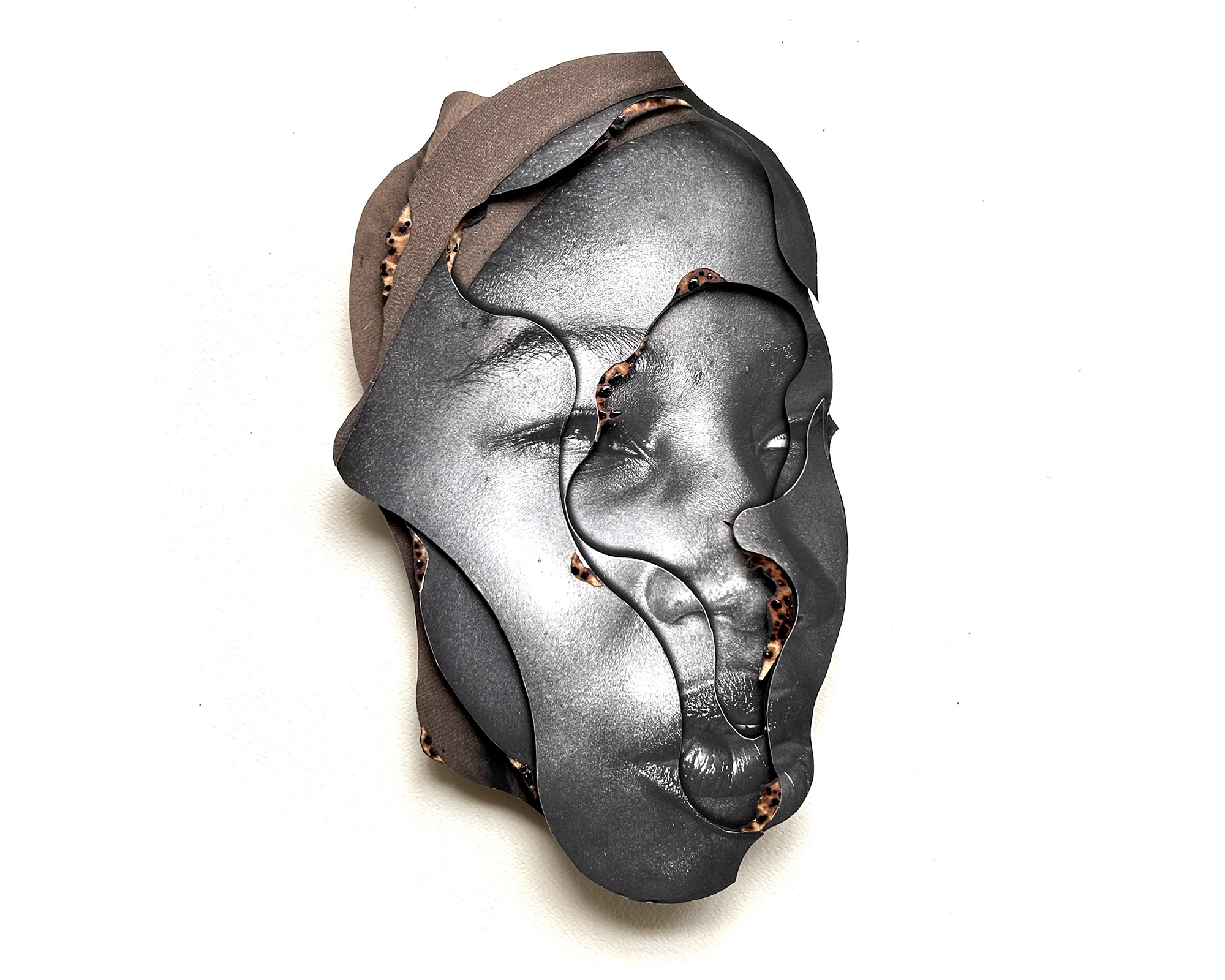The artist’s approach to portraiture allows for something that most do not: absence
At a crowded group exhibition opening, an image of a young woman’s face held my attention. Turned in three-quarter profile, it was a composite, collaged from three cutout black-and-white photo portraits, layered to create something new. The top layer shows the left side of her face, the edge of her lip, eye and brow. Under this, the second layer depicts a large part of her forehead, the centre fraction of her eye, her brow and a small slice of nose. And beneath that, at the centre of the portrait, lies the third layer, which completes the woman’s face.
The image, titled Zara, One Within the Other (2025), belongs to Portraits (2022–), a series in which Mobolaji Ogunrosoye uses similar photocollage techniques to convey the diverse experiences of womanhood. The portrait’s title, as with its form, points to the multifaceted personality of the young woman portrayed. More intriguingly, it allows for something that most portraits do not: absence. For instance, it is difficult to read the expression on the young woman’s face, as the holes and overlaps in each layer appear to conceal as much as the whole reveals. What can be seen is that her gaze is focused. But the position of her lips, which appear pressed in the first and second layers, but slightly parted in the third (to reveal teeth), suggests a stern demeanour. Albeit stacked over a smiling face. As if one moment had been gently placed atop another. Here, we experience a different type of portrait. One in which we are confronted by the limitations of a person’s face as a vehicle for fully channelling personality. And the limitations of a photograph in truly representing what it claims to depict.
To achieve this, Ogunrosoye adopts what appears to be a straightforward process. She speaks to her subject, takes photographs of the person and then retreats to her studio. Her goal is not to make a realistic likeness, but a representation that looks beyond the surface, that suggests an essence but acknowledges what remains elusive about the person with whom she interacted. The images are then printed on different papers, while at points coffee granules are used to create colour and texture, and some edges of the papers are burnt, making the final image appear as if it were torn from the skin of the sitter’s face and then cauterised.
In our hypervisual society, where images are at the centre of most interactions, one’s face validates one’s identity: from the freer and more expressive forms of social-media profile photos to the regulated and standardised passport image. This centrality of images means that a photograph can often substitute for physical presence itself. For instance, in some communities in southeastern Nigeria there are cases where, in the absence of the body of the dead, a photographic portrait of the deceased is placed in a casket and committed to the earth.
A photo of a person’s face might serve for the purposes of identification. But a face does not reveal one’s character, multilayered personality or rich interior life. Indeed, what does? But despite all that, a person’s face does contribute to how one is perceived. This was exemplified and utilised by the pseudoscientific practice of physiognomy – popular in the eighteenth and nineteenth centuries, but which now finds a resurgence in ai technology that uses facial profiling to predict, among other things, a person’s ‘threat level’. Largely trained with images of faces bearing Eurocentric features, the AI software carries forward the biases of its trainers, such that its crude analysis of faces with Afrocentric features – wide nose, dark skin – mostly leads to inaccurate and negative outcomes. And so, the persons in the analysed portraits are simplified both by the limitations of the image and by the presentation of the face, just as much as they are by the stereotypes and prejudices of those in positions of authority.
A portrait also yields itself easily to emulation. Appearances can be manipulated. One can aspire to the appearance of another – their pose, mien, attire – and then recreate it for oneself. I think, for example, of Samuel Fosso’s African Spirits (2008), a self-portrait series, in which the photographer assumes the poses of key historical figures from the Black liberation movement. Zara, however, resists this easy replication. This refusal of legibility could be read as a form of resistance – effectively to the world of facial-recognition technologies and the reductive stereotyping that comes with it. But you might also view it, more fundamentally, as a resistance to simplification. The layered form of the portrait highlights these absent presences, those parts of the self that exist but remain unseen by the public eyes. Only the subject might see herself fully in the distortion; only she might recognise, in the three layers of skin, her separate selves that may pass unnoticed in the world. Then again, she might not. At its core, Ogunrosoye’s approach disturbs the carefree assumptions we make when we look at a person. It forces us to ask ourselves: who do you see when you look at the face of another?
From the November 2025 issue of ArtReview – get your copy.
Read next How Frida Orupabo reconfigures Black female sexuality
